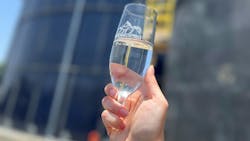How PepsiCo Foods North America is conserving water and driving change

For PepsiCo Foods North America (PFNA), water is both a precious resource and a necessity for its business.
Melissa Jones, the water program leader at PepsiCo Foods North America, has turned her passion into a career. Jones initially joined PepsiCo’s marketing department but quickly found her passion in sustainability. She helped create the Green Team at Frito-Lay’s corporate headquarters in Plano, Texas, and has transitioned her career into a focus on sustainability. Today, she helps the PFNA team continue to conserve water through three main areas of focus: people, processes and technologies, aiming to advance PepsiCo’s goal to become Net Water Positive by 2030.
Water Technology recently connected with Jones to discuss PFNA’s water-related initiatives.
How is the team at PepsiCo Foods North America helping PepsiCo in its goal to become Net Water Positive by 2030?
Water stewardship has long been one of PepsiCo Foods North America’s top priorities, and we are one of the first companies of our size to acknowledge access to water as a human right. Our vision is that wherever in the world we operate, water resources will be in a better state because of our presence. To further this initiative, we are working to improve water-use efficiency across our value chain — including on farms and in manufacturing facilities — replenish water and improve the health of high water-risk watersheds where we operate, and increase safe water access for communities that face water insecurity.
What are a few examples of PFNA recent projects that have made the biggest impact in reducing water?
PFNA’s efforts to reduce water use impact multiple processes within the company’s operations. One of PFNA’s recent advancements is the development and scaling of a cooking process for corn used to make Tostitos, Fritos and Doritos, through which we have observed an average of 70% less water compared to prior technology, without sacrificing quality or food safety.
Additionally, PFNA has developed custom technology to capture and recirculate water used during the potato slicing and peeling processes, which helps to reduce the amount of freshwater used to make snacks such as Lay’s and Ruffles.
We also prioritize resource conservation (“ReCon”) processes at our sites in sharing best practices and standards with our sites. These small every day actions can add up to a big water savings impact over time.
How have partnerships also helped PFNA move the needle on some of these larger projects?
We recognize that acting alone cannot have as strong of an impact as collaborative action. PFNA has partnered with multiple organizations and groups with specialized goals for sustainability. PFNA currently participates in the Alliance for Water Stewardship, a global membership collaboration dedicated to promoting a universal framework for the sustainable use of water. Through this collaboration, PFNA is doing its part to stay educated and involved with the evolving landscape of water conservation. This includes continuing to adopt the AWS Standard at our high water-risk facilities, using it as a vehicle for advocacy and to help ensure that freshwater resources in high water-risk locations where we operate are available for all water stakeholders.
Additionally, we have established partnerships with organizations such as Trout Unlimited to drive our goal of replenishing and restoring local watersheds. Through our partnership with Trout Unlimited, we are working to build a mile-long channel to connect two segments of the Colorado River blocked by the Windy Gap Reservoir near Denver.
What technology is next that could really help cut down on water? And what are some of PFNA’s upcoming projects in that regard?
One of PFNA’s recent advancements in water conservation technology is focused specifically on our cooking processes. PFNA is working to implement technology that captures water and heat released from potatoes during the frying process, so that it can be treated and reused at the site. This technology is already being used in India and we are working to expand it to further our larger resource conservation initiatives.